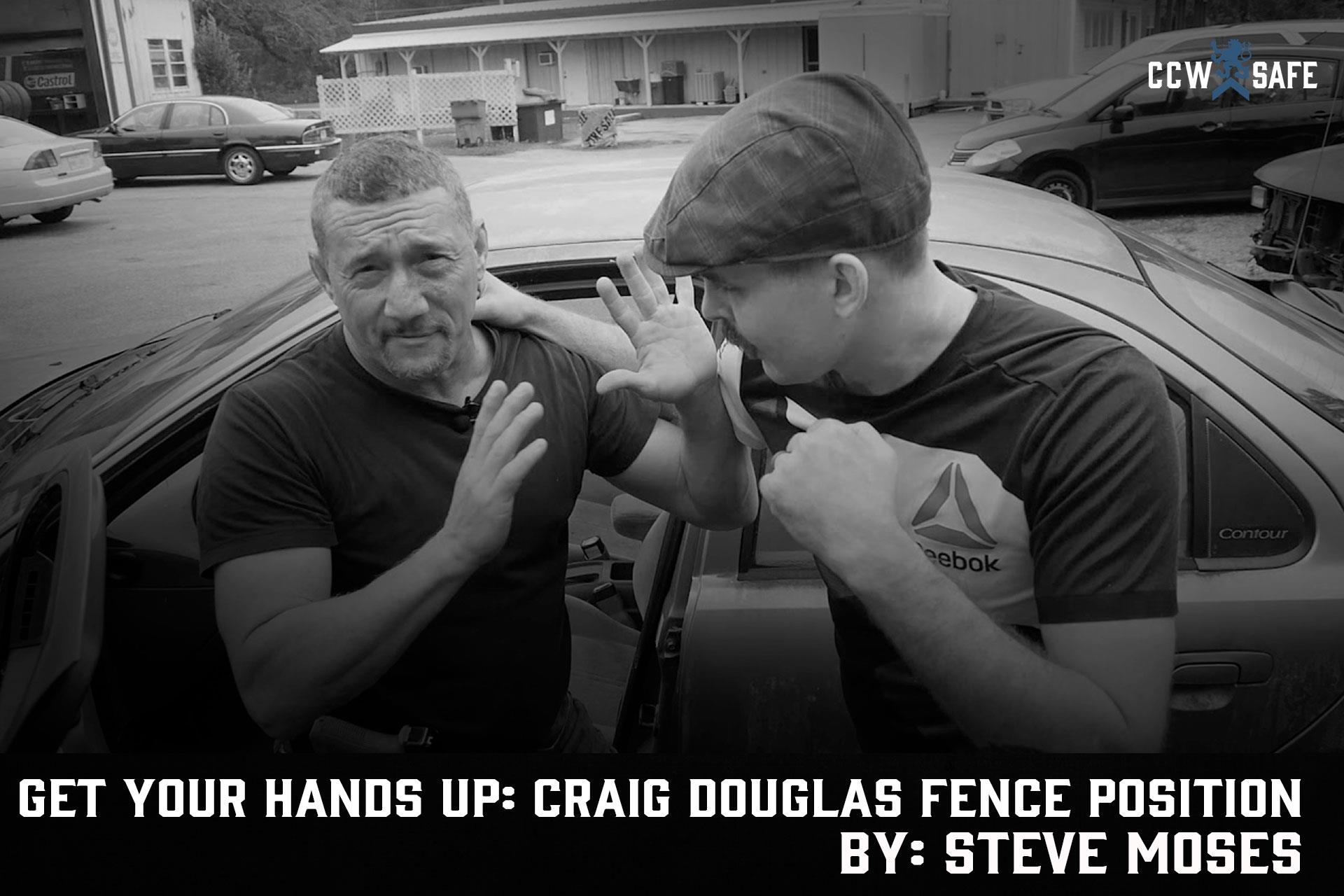
Posted on February 1, 2021
GET YOUR HANDS UP: CRAIG DOUGLAS FENCE POSITION
GET YOUR HANDS UP: CRAIG DOUGLAS FENCE POSITION
I first learned about the “Fence” Position from world-class firearms instructor Craig Douglas nearly 20 years ago in one of his early Extreme Close Quarters Concepts classes. Craig (AKA “Southnarc”) is well-known throughout the defensive training industry as one of the most innovative defensive firearms and tactics instructor anywhere in the world at this time for his development of a codified self-defense system that is based upon integrating multiple disciplines. I personally liken it to modern-day Mixed Martial Arts (“MMA”).
A modern-day MMA fighter is one whose repertoire includes blended techniques and skills from Brazilian Jiu Jitsu, Muay Thai, Karate, Western boxing, and wrestling. A good MMA fighter has the ability to transition seamlessly from a technique from one system to a technique from another in such a way that his (or her) opponent has difficulty in keeping up. This is truly an example where the whole is greater than the sum of its parts. The system that Douglas teaches has much in common in that his students learn how to defend themselves against violent criminal actors in much of the same manner by blending situationally appropriate empty hand, small fixed-blade knife, and handgun skills. In my opinion, he does not get sufficient praise for the effort he puts into teaching critical people management skills that are designed to both stop assaults before they happen and set students up for success if they do.
Craig teaches pre-engagement tactics that are predicated upon consistently maintaining sufficient distance from an unknown and potentially violent contact in such a manner that the other finds it difficult to get close enough to readily initiate an assault. Regardless of the weapon of choice (fists, knives, blunt instruments, or even handguns), the greater the distance between predator, angry drunk, or enraged motorist and the concealed carrier the better. Students are taught to keep their hands up and moderately extended anytime they are managing an unknown contact. He refers to this position as the “Fence” position, and gives much attribution to Geoff Thompson, a martial artist, nightclub doorman (often referred to as a “bouncer”) in England, and author of the book “The Fence: The Art of Protection.” Thompson was one of the first persons to address the importance of pre-fight psychology and describe in detail why in any interaction with another person whose intent is suspect strategic initial positioning on behalf of the concealed carrier can dramatically improve their chances of responding effectively if subsequently threatened or attacked.
Craig believed that there was a disconnect between what was being taught in the martial arts community and what typically happens during the majority of violent street crime incidents. The majority of traditional (and more contemporary) martial arts disciplines do not work well when a streetwise violent criminal offender or even a guy at a bar with serious anger management issues slings a surprise punch inside of arms-length distance. This is even more true if the punch is thrown from the side or the back of the intended target. Douglas teaches the use of the Fence position in conjunction with a non-diagnostic default blocking position that helps protect the more vulnerable portions of the head and neck irrespective of the direction from which a punch or strike was thrown. He refers to this technique as “Default Cover.” I have heard other instructors refer to it as “Three-Point Cover” and the “Cage.”
What is the Fence position and why do I think that it is so important? I assume the Fence position by bringing my hands up to a position where my fingertips are at approximately chin level and extend them slightly outwards. Both hands are open and either facing palms-in with fingertips touching or palms-out. Both biceps are in light contact with my torso. The position that I assume is relatively relaxed and loose, and I make an effort to avoid any unnatural poses. I tend to “talk” with my hands when I interact with others anyway, and this tendency works well from the Fence position. There are multiple reasons that I think the Fence position is important. It establishes a boundary (an imaginary fence) between the other person and me that normal persons who intend to do no harm respect.
Anytime that a person continues to encroach upon me while I am in this position (and ideally requesting or demanding that he or she stays back) is giving me reason to believe that I had better be prepared to defend myself without any advance notice. My default response to another aggressively closing on me to the point that I can touch them is to respond physically in some manner, the level of force used being entirely dependent upon the circumstances. One of my biggest concerns has always been dealing with someone who suddenly throws a “sucker punch” or simply charges at me.
The very fact that the position of my hands makes doing that less likely to be successful may discourage another person from taking such an action, and if they attempt it anyway the odds that I will be able to successfully achieve a blocking position capable of keeping me both fully conscious and upright are now in my favor. One of the major reasons that concealed carriers should know how to use the Fence position is the fact that it is nearly impossible for the average young male to block a sucker punch thrown correctly if his hands start at waistline level or below regardless of how quick his reaction time is. It simply takes too long to see what just took place, process that information, and cover the distance from below the waistline to the head fast enough to block the punch. The same is not true when the hands start out much closer to head level. The proof can be found by simply going to ESPN and watching a show covering the sport of boxing. At no time will we see a professional boxer standing with his hands at waist level while at arms-length distance from another boxer.
Both the Fence position and Default Cover are key components of Craig’s system of Managing Unknown Contacts (“MUC”), which is a pre-engagement system using consistent methodology to interact with strangers or known persons behaving in a suspicious manner. MUC was developed in part based upon Craig’s experience as an undercover narcotics officer buying illegal drugs. Douglas was robbed or assaulted (and at least once seriously injured) during some of those buys. He studied videos of these assaults on himself and other undercover narcotics officers whenever possible in order to analyze how these violent criminal actors would move in for the purpose of engaging their intended victims.
Some readers will not have the opportunity to study under Craig Douglas or other trainers teaching similar material. While I fervently wish that they would, I also understand. Regardless, a concealed carrier will likely be significantly better off if caught up in a close-range interaction with another person if they simply keep their hands up closer to their face for the duration of the event.
I recommend that readers take fifteen minutes or so to catch a TriggerTimeTV video of Craig on YouTube discussing how to survive the sucker punch and my May 6, 2019 CCW Safe article titled “Craig Douglas on Managing Unknown Contacts.”
 |
Steve MosesSteve Moses has been a defensive firearms trainer for over 26 years and is a licensed Texas Personal Protection Officer with 7 years of experience performing as shift lead on a church security detail for a D/FW area metro-church. Steve is a co-owner and Director of Training for Palisade Training Group, LLC based in Dallas, Texas. Moses is a retired deputy constable and spent over 10 years on a multi-precinct Special Response Team. He owns multiple instructor certifications, including Rangemaster Advanced Handgun Instructor and Defensive Shotgun Instructor, Red Zone Knife Defense Instructor and Adaptive Striking Foundations Instructor, Modern Samurai Project Red Dot Sight Instructor, and State of Texas Personal Protection Officer Instructor. Steve holds a BJJ Brown Belt in Relson Gracie Jiu Jitsu. He is a content contributor for CCW Safe and writes weekly articles on various subjects of interest to concealed carriers. Moses shoots competitively and holds an IDPA Expert rating. Steve is an annual presenter at the Rangemaster Tactical Conference. |